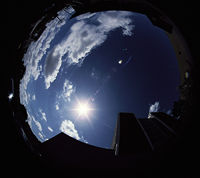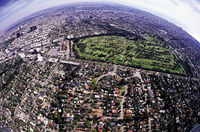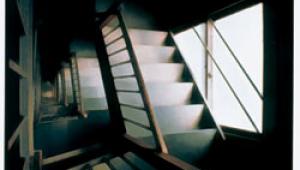Choosing and Using Lenses Page 5
| Special-Purpose Lenses Macro Lenses—As their name suggests, macro lenses are ideal for macrophotography (serious close-up shooting). They have extended focusing mounts so that they can focus on subjects close enough to produce life-size (1:1) images on the film (naturally, these images can be blown up even more when printed or projected). Macro lenses are also optically optimized for close-up work (standard lenses are optimized for moderately distant shooting) and produce better image quality than other lenses in this type of photography. Macro lenses generally come in normal (50mm or 60mm), short telephoto (100mm to 105mm), and telephoto (180 or 200mm) focal lengths. Longer macro lenses produce a given magnification from farther away than shorter ones—handy when dealing with subjects you can't (or don't want to) approach too closely. Note: Most "macro" zoom lenses are aren't really "macro"—most will focus closely enough to provide 1/4- or 1/5-life-size images on the film; and they're not specially corrected for close-up work. (True macro lenses focus down to life size [1:1], or at least half life size [1:2]). Featuring the shortest focal lengths of all (6-16mm), fisheye lenses have angles of view so wide (180° or greater) that they produce round images on the film instead of the usual rectangular ones. Fisheyes produce lots of barrel distortion—any straight lines not going through the center of the image will be curved (including the horizon line if you tilt the camera up or down). Circular fisheyes produce the typical 180° circular fisheye image. Full-frame fisheye lenses "crop" a rectangle out of the circular fisheye image to fill the film frame, thus providing a 180° angle of view measured diagonally (from corner to corner). Because the front elements of fisheye lenses are spherical rather than flat (and, in the case of circular fisheyes, rather large), it's difficult if not impossible to attach screw-mount filters. So, most fisheyes provide built-in filters (generally, a few colored ones and a neutral-density filter) or a filter slot near the rear of the lens that accepts smaller filters. Perspective-control lenses let you correct converging parallel lines when the camera is pointed at an angle to the subject, as when tilting the camera up to get a whole building in a shot. When you tilt the camera up, the film plane is no longer parallel to the subject plane, so the building's vertical lines converge near the top of the photo. Perspective-control lenses (also called shift lenses) have front elements that can be shifted up or down or left or right, so instead of tilting the camera up to get a whole building in the photo, you can just shift the front element up to do it, while keeping the camera pointed straight ahead. Since the film plane remains parallel to the subject plane, there's no convergence. PC lenses are generally 24-35mm wide-angles, because longer lenses would still require tilting the camera up to get a whole building in the frame, even at maximum shift of the front lens element. Canon offers three manual-focus tilt/shift lenses for its EOS AF SLR cameras, in 24mm, 45mm and 90mm focal lengths. Besides shifting up, down, left and right, these lenses can be tilted 8° to provide view-camera-style depth-of-field control via the Scheimpflug principle (i.e., depth of field is greatest when lines drawn through film, lens and subject planes meet at the same point). Soft-focus lenses produce a soft, glowing image of the subject—a pleasant effect considerably different from the unpleasant effect of out-of-focus images made with a regular lens, or blurred images caused by camera or subject movement. The soft effect is greatest at maximum aperture; when the lens is stopped down. Most soft-focus lenses for 35mm cameras have control rings that allow you to adjust the degree of spherical aberration (and hence, softness) from great to none. You can simulate the effect of a soft-focus lens by making a double exposure with a regular lens: Make the first exposure in focus, then make a second exposure on the same frame with the lens focused too close or too far for the subject. It's best to mount the camera on a tripod for this, to keep the two images in register. Caring for Lenses When removing or attaching a lens, don't force it. Read the camera manual for the proper procedure (it generally involves aligning an index mark on the lens with an index mark on the camera's lens mount) and follow it. If the lens doesn't lock into place or release easily, you're probably not following the procedure in the book. And, of course, don't drop the lens (or camera)! When the lens is not attached to the camera, keep it capped front and rear (lenses do come with front and rear lens caps—don't lose them). Keep the lens in its case or in a padded compartment of your camera bag when not in use. Some experts recommend keeping a skylight or UV filter on the lens at all times for protection—the filter will absorb the dirt and dings that the front lens element would otherwise suffer. Other experts point out that the filter is an excuse not to be as careful with the lens and it adds two more glass or plastic surfaces to degrade image quality. They recommend using a filter only when its specific effect is needed—or if the lens is endangered by blowing dirt or sand. In any event, keep the filter clean and scratch free if you use it, otherwise you'll be better off without it. Keeping your lenses capped when not in use will help them stay clean, but sooner or later, the front and rear elements will need cleaning. Cleaning them properly will keep the lens ready to shoot sharp photographs. First, use a soft camel's-hair lens brush to gently flick away large dust particles from the lens surface. Next, blow away remaining particles with a blower brush or spray can of compressed air (don't spray the air directly at the lens; spray at an angle to the surface). Apply a small amount of photographic lens-cleaning fluid to a piece of photographic lens-cleaning tissue (never apply liquid cleaner directly to the lens—it might seep inside the lens around the edges of the element). With a drop or two of fluid on the tissue, gently clean the lens using a circular motion, starting at the center of the glass and working out to the edges. Work gently—while photographic tissue is not likely to scratch the glass, it's very easy to scratch the fragile multicoatings, and a scratch on either produces the same effect: degraded images. Finally, gently buff the lens with a fresh, dry piece of lens tissue. |
- Log in or register to post comments




























































